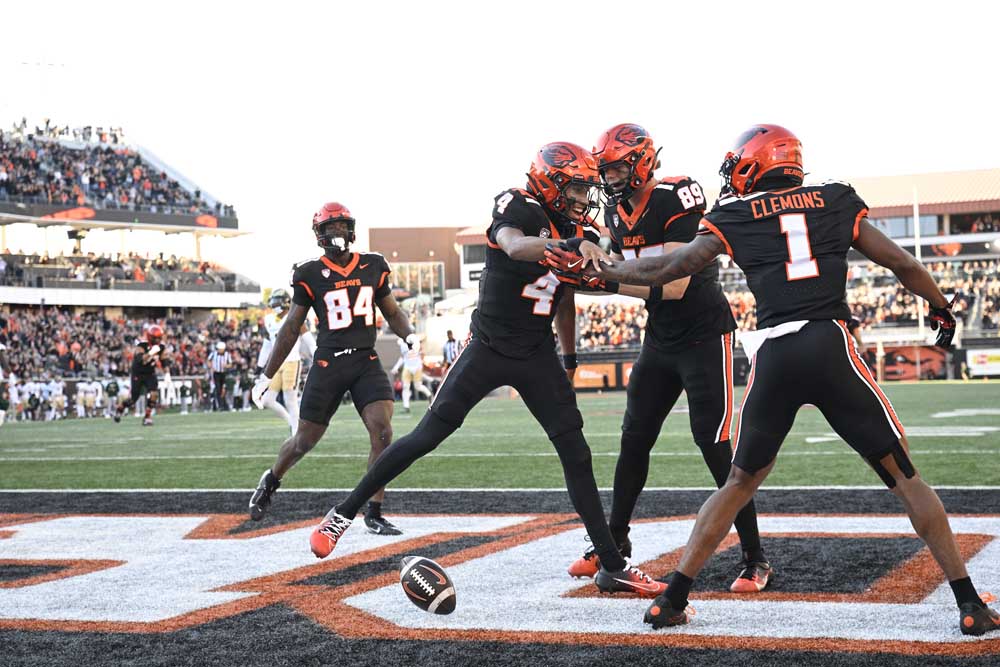Oregon State football 2024 end of season report cards: Offense
Published 12:53 pm Monday, December 2, 2024

- Oregon State quarterback Gevani McCoy (4) celebrates with teammates Darrius Clemons (1), Bryce Caufield (89) and Jermaine Terry II (84) after a rushing touchdown in the Beavers' 39-31 win over Colorado State on Saturday, Oct. 5
The curtain has drawn on the 2024 football season for Oregon State, so what a better time than now to take a look back at the season’s performances?
Trending
For each position group on offense and defense, we’ll issue a report card grade from A to F.
Injuries were a running theme throughout the year, but details on who was injured or what injuries were were few and far between. For that reason, position groups that struggled with injury for parts of the season won’t be given an asterisk. After all, the best ability is availability.
This story will not account for players who have already announced their transfer at the time of writing or will after the publication of this article. For updates on the transfer portal, click here or on the headline below for our transfer portal tracker.
Trending
With the housekeeping out of the way, let’s get into the offense’s report cards!
Quarterback: C-
Starting with everyone’s favorite position, the one that needs the most explanation and the most confusing for the Beavers in 2024, we’ve got a C- for the quarterbacks.
Gevani McCoy finished the season as the leading passer with 1,300 yards, three touchdowns and six interceptions. He also added 328 rushing yards and five scores on the ground. McCoy played the bulk of seven games and started nine, accounting for a 4-3 record where he played the majority and a 4-5 record in his total starts.
Ben Gulbranson played the majority against Cal, missed the Air Force game with a concussion and started against San Jose State, Washington State and Boise State. The redshirt junior passed for 943 yards with four touchdowns, four interceptions and a 1-3 record where he played the bulk of snaps.
Gabarri Johnson never started, but saw an off-and-on role throughout the year. He passed for 174 yards, throwing an interception and ran for 106 yards with his only touchdown being a rushing score against Washington State.
The C- is earned for the mixed-bag that quarterback play was all year. Both McCoy and Gulbranson had A+ moments and both had F-worthy moments, while Johnson’s sample size was too small to effectively grade him.
McCoy looked like a bonafide dude before he was benched (sans the interceptions at Nevada, many of which were not inherently his fault), but couldn’t recapture the magic when he got back in the mix at Air Force.
Gulbranson had moments, but second-half interceptions crippled the Beavers with him under center.
Johnson is still incredibly young, and with the turbulence at the position and him still not getting a real chance to start, its clear there’s much development yet to be done before he can fully helm an offense.
Running back: B
If this had been written following the win over Colorado State, running back would get an A+. The loss of Jam Griffin in that game — which turned out to be a season-ender — was a devastating one and the Beavers never really got back to the rushing attack they showed the first month of the year.
Perhaps that was a competition thing, but the position became really thin with Griffin’s absence.
Anthony Hankerson finished the season strong, breaking 1,000 yards and scoring 15 touchdowns and Salahadin Allah flashed some real promise as a true freshman. But following Griffin’s injury, the Beavers went from averaging 5.4 yards a carry to 4. It doesn’t seem like much, but it was a big blow to the offense.
So, we land on an even B, lots of promise but lost steam as they simply ran out of bodies.
Wide receiver: C
Wide receiver play is incredibly dependent on stable quarterback play, but even with that being true, you’d still expect more than one receiver to have more than 500 yards.
That wasn’t true for Oregon State this season. Trent Walker had himself a phenomenal year with 81 catches for 900 yards. Darrius Clemons was second amongst receivers with 292. It’s a big drop off, especially when the No. 2 guy played in just nine games.
It was always going to be a young and inexperienced group, with not a single one of them having been significant contributors in their college careers. There are lots of interesting pieces beyond Walker and Clemons, with Taz Reddicks showing flashes and young players like Zachary Card contributing in specialized roles, but still lots left to be desired. They get a C.
Tight End: D
Jermaine Terry II finished as the No. 2 receiver with 375 yards and one touchdown, but it just wasn’t a position group Oregon State got a lot of use out of in the passing game.
As for contributing as blockers in the run game, Terry II and four other tight ends — Cooper Jensen, Bryce Caufield, Gabe Milbourn and Andy Alfieri (who moved over to defense) — saw snaps. None of the five were graded by Pro Football Focus above the bench mark grade of a 60. Milbourn had the highest at a 56.4 and Terry II the lowest at a 40.6.
In short, it wasn’t great. The group gets a D as mostly non-factors in the pass game and not performing in the run game.
Offensive Line: B+
The Beavers offensive line allowed 25 total sacks in 12 games. An average a little over two per contest sounds high, but they finished basically dead middle in the FBS in the stat with a three-way tie for No. 69 nationally. According to PFF, only 12 of those were directly credited to an offensive lineman.
The addition of Gerad Christian-Lichtenhan proved to be an important one, with the left tackle posting the highest PFF offensive grade amongst players who played 12 games with an 81.8. Another Colorado transfer, center Van Wells, was also effective when he could stay on the field, allowing just seven pressures on 306 pass-blocking sets.
The Beavers also finished as the No. 33 rushing offense in the nation, much of that credit goes to the offensive line.
The big uglies get a B+. Injuries forced reshuffles of the five throughout the year, but the core of Christian-Lichtenhan, left guard Joshua Gray and right tackle Grant Starck held it together throughout the season.
Cumulative Grade: C
A rough average of all the grades earns the Oregon State offense a cumulative C.
They flashed good signs at points in a variety of way. The Beavers started the season as a run-heavy, grind out yards team and were slinging it around against San Jose State and Washington State at points. In between those, they looked completely incapable of moving the ball in any form.
The offense, right now at least, lacks a clear identity.
They feel somewhat trapped between a more under-center, run-first offense that Jonathan Smith’s regime hung its hat on and branching into more of the Chip Kelly spread-style that offensive coordinator Ryan Gunderson hails from the tree of.
Every part of this team is in rebuild mode, so the 2025 offseason should give more of a window into what direction head coach Trent Bray and Gunderson want the team’s identity to be going forward.
That wraps up the offense’s report cards, stay tuned for defense!







